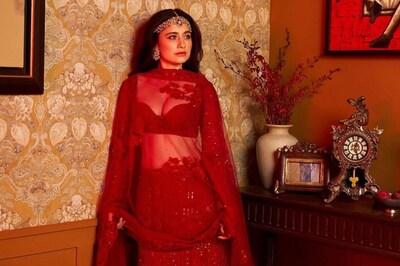
views
Amid chanting of Vedic hymns followed by a multi-faith prayer, Prime Minister Narendra Modi on Sunday inaugurated the new Parliament building even as 20 opposition parties stayed away from the historic event. The prime minister described the ceremony as an “immortalised” moment marking the dawn of a self-reliant and developed India that will inspire the progress of other countries.
The ruling BJP at the Centre held onto its resolve of moving ahead with the grand ceremony, which culminated in Prime Minister Modi prostrating before ‘Sengol’, the ceremonial sceptre that traces its tradition back to the Chola dynasty in the third century BCE. High priests of 21 adheenams from Tamil Nadu consecrated the ‘Sengol’ and handed it over to the PM, who carried it in a ceremonial procession to the new building and installed it on the right side of the Lok Sabha Speaker’s chair, amid claps and chants of ‘Modi, Modi’.
While medal-winning wrestlers protested against sexual harassment outside and were detained by police, Prime Minister Modi said the new Parliament reflected the aspirations and resolve of India, the “mother of democracy”. “Every decision taken here will lay the foundation of India’s glorious future… the way to empower the poor, Dalits, backwards, tribals, divyangs and other marginalised sections goes through here,” he said, adding “each brick and wall of this Parliament building should be dedicated to the welfare of the poor.”
Congress leader Rahul Gandhi slammed the “self-serving” nature of the inauguration, saying the PM had treated the event as if it was his “coronation”. Despite the boycott by opposition parties over President Droupadi Murmu being sidelined, however, close to 25 political parties attended the event amid tight security arrangements. In her speech later, Murmu expressed deep satisfaction at the inauguration by PM Modi who, she said, symbolised Parliament’s trust.
Modi, flanked by peacock motifs in the Lok Sabha during his first address, spoke of shedding “slave mentality” that had crept into the country after hundreds of years of bondage. He equated the 25-year period — from now till the centenary of India’s independence in 2047 — to the similar time gap between Mahatma Gandhi’s non-cooperation movement that had ended in 1922 and the country’s freedom.
“The new Parliament is a reflection of aspirations and dreams of 140 crore Indians. This is a temple of our democracy that gives a message of India’s resolve to the world. There are a few moments in every nation’s history that are immortalised. Some dates become the indelible signature on the face of time. May 28, 2023, is one such day,” he said.
Here’s all you need to know about the elaborate inaugural ceremony of the new Sansad Bhawan:
Havan, multi-faith prayer, Sengol installation
The inauguration began with an early-morning havan, multi-faith prayer ceremony and installation of the Sengol in a special enclosure in the Lok Sabha chamber. Modi, dressed in a crisp dhoti and kurta for religious ceremonies, performed Ganapati homam as part of the Vastu pooja rituals.
All-religion prayers along with spiritual strains of Shaivite hymns from the sacred Thevaram text set the tone for the ceremonial rituals. Priests from Sringeri Math of Karnataka performed the ceremonial Vastu pooja.
The central government released a commemorative postal stamp and a Rs 75 coin to mark the occasion. The PM also pointed out that the construction of the new building gave employment to 60,000 workers and a digital gallery dedicated to them has also been built in the complex. He felicitated some of the workers for their key role in the construction, with shawls and souvenirs.
Who all attended the inaugural ceremony?
The formal inauguration function was attended by former president Ram Nath Kovind, Uttar Pradesh chief minister Yogi Adityanath among others. Andhra Pradesh CM YS Jagan Mohan Reddy was the only non-NDA leader in attendance. Chief ministers of NDA constituent parties such as Eknath Shinde (Maharashtra), Conrad Sangma (Meghalaya), Zoramthanga (Mizoram), Neiphu Rio (Nagaland), and Prem Singh Tamang (Sikkim) were present, along with ambassadors of several foreign countries, parliamentarians and people from different walks of life.
New building completed in record time, numerous artworks & traditions imbibed
The old Parliament building took six years to complete, but the new building — spread over a built up area of 64,500 sqm — was ready in a record time of two-and-a-half years at an estimated cost of nearly Rs 1,200 crore. The Lok Sabha chamber has 888 seats, which can accommodate 1,272 members during a joint sitting of the Lok Sabha and the Rajya Sabha. The Upper House chamber has 384 seats.
Constructed by Tata Projects Ltd, the building opens into a central courtyard with a banyan tree. It has a grand Constitution Hall to showcase India’s democratic heritage, a lounge for MPs, a library, multiple committee rooms, dining areas and ample parking space. It has three main gates — Gyan Dwar, Shakti Dwar, and Karma Dwar.
It also has six new committee rooms and 92 rooms for use as offices for the council of ministers. The Lok Sabha and the Rajya Sabha chambers boast of a digitised voting system, well-engineered acoustics, and state-of-the-art audio-visual systems to ensure effective legislative proceedings.
Numerous artworks on display narrate the stories of India’s democratic traditions from the Vedic period to the present day. The growth of democracy is depicted through a series of exhibits in the Constitution Hall, which is inspired by the Sri Yantra used for worship in Hindu traditions and considered a source of pure energy. The public entrances lead to three galleries — the ‘Sangeet’ gallery that exhibits dance, song, and musical traditions of India; ‘Sthapthya’ gallery depicting architectural heritage of the country; and ‘Shilp’ gallery showcasing distinct handicraft traditions of different states.
The building has close to 5,000 artworks, including paintings, wall panels, stone sculptures, and metal murals. Interior decoration has peacock motif on carpets, ceiling and lattice work for windows in the Lok Sabha, while the Rajya Sabha is decorated with lotus motif.
The Constitution Hall, which has a digitised copy of the Indian Constitution, houses Foucault’s Pendulum to demonstrate the rotation of the earth. It hangs from a large skylight from the triangular roof and signifies the idea of India with that of the universe.
Massive brass images of Mahatma Gandhi, Chanakya, Gargi, Sardar Vallabhbhai Patel, BR Ambedkar, and the chariot wheel from the Sun Temple at Konark are on display. According to officials, eminent musicians and their family members – Ustad Amjad Ali Khan, Pandit Hariprasad Chaurasia, Ustad Bismillah Khan, Pandit Ravi Shankar – have donated their musical instruments for the Sangeet Gallery.
(With PTI inputs)
















Comments
0 comment